Apr 24, 2022
In 2020 1A~0535+262 surprised us with a quite spectacular outburst, which allowed to exploit Insight-HXMTto it's fullest and part of the results appear now in our paper led by collegues from IHEP. We focus on the two-dimensional dependence of the cyclotron resonance scattering features (CRSFs) along the outburst time and at different phases. The basic result seen also in figure below is that CRSF fundamental shows different time- and phase-dependent behaviors compared to harmonic.
 Based on these results, we speculate that when the source enters the supercritical regime, the higher accretion column can significantly enhance the harmonic line at a narrow phase through an "anti-pencil" beam at a higher energy band. At the same time, it will also affect the behavior of the fundamental line.
Based on these results, we speculate that when the source enters the supercritical regime, the higher accretion column can significantly enhance the harmonic line at a narrow phase through an "anti-pencil" beam at a higher energy band. At the same time, it will also affect the behavior of the fundamental line.
Feb 17, 2022
We further elaborated on our work with Valery on intermediate polars to get better constrains on their luminosity funciton and numbers in Galaxy.
It turns out the Mily Way is full of accreting white dwarfs we don't see because they are far away and faint as we discuss in our newest paper!
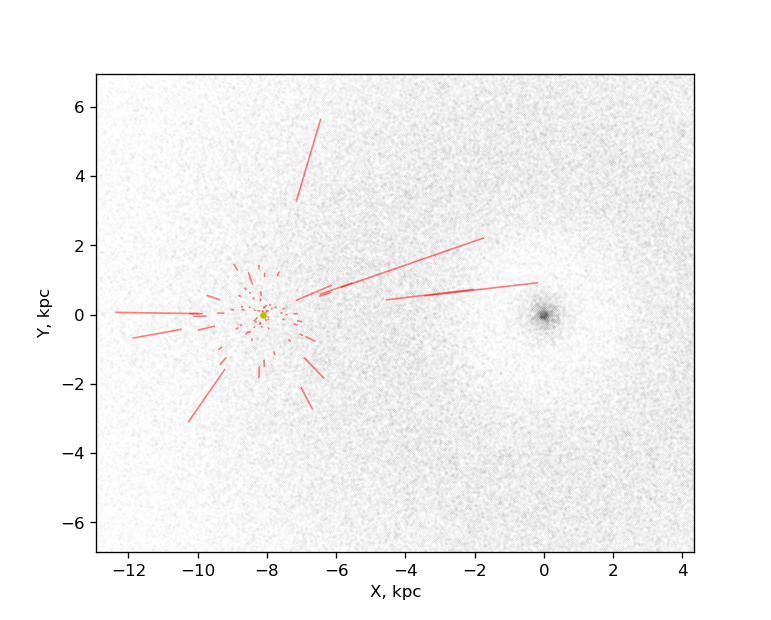
in the image above you can actually see those 340000 thousand (well, less, because it's only part of the Galaxy visible) objects along with about eighty which we actually know.
Those are shown as red lines to reflect the uncertainty on distance to those which remains even after Gaia EDR3 release became available.
Aug 06, 2021
Another nice result by Insigh-HXMT and Chinese collegues (with a little help from the friends)! It seems that our results on V 0332+53 are not all that strange, and other BeXRBs might exhibit similar behavior!
The abstract is below
Basic idea is that we were finally able to see anti-correlation of line energy with luminosity in this source, and moreover, also transition from positive to negative correlation, and transition from sub- to super-critical regime!

"We report on a detailed spectral analysis of the transient X-ray pulsar 1A 0535+262, which underwent the brightest giant outburst ever recorded for this source from November to December 2020 with a peak luminosity of $1.2\times10^{38}$ erg s$^{−1}$. Thanks to the unprecedented energy coverage and high cadence observations provided by Insight-HXMT, we were able to find for the first time evidence for a transition of the accretion regime. At high luminosity, above the critical luminosity $6.7\times10^{37}$ erg s$^{-1}$, the cyclotron absorption line energy anti-correlates with luminosity. Below the critical luminosity, a positive correlation is observed. The 1A~0535+262 becomes, therefore, the second source after V~0332+53, which clearly shows an anti-correlation above and transition between correlation and anti-correlation around the critical luminosity. The evolution of both the observed CRSF line energy and broadband X-ray continuum spectrum throughout the outburst exhibits significant differences during the rising and fading phases: that is, for a similar luminosity the spectral parameters take different values which results in hysteresis patterns for several spectral parameters including the cyclotron line energy. We argue that, similarly to V~0332+53, these changes might be related to different geometry of the emission region in rising and declining parts of the outburst, probably due to changes in the accretion disk structure and its interaction with the magnetosphere of the neutron star."
Jun 29, 2021
For those of you who wondered what eRosita data is like, you can now take a look!
MPE, ourselves and other core institutes of the German consortium have prepared press-releases to celebrate this major milestone.
The early data release (EDR) contains almost 100 individual observations of 29 distinct fields taken before the start of the all-sky scans. They cover a wide range of different astronomical objects, from galactic neutron stars to clusters of galaxies (see figure below) and showcase the potential and versatility of the eROSITA telescope for imaging, spectroscopy and time domain analysis. Arguably the most interesting part of the released data is the final equatorial depth survey (eFEDS) which covers over 140 square degrees of the sky to depth of $\sim10^{-14}$ erg/cm$^2$/s comparable to final sensitivity which eRosita will achieve over equatorial areas in the ongoing all-sky survey.
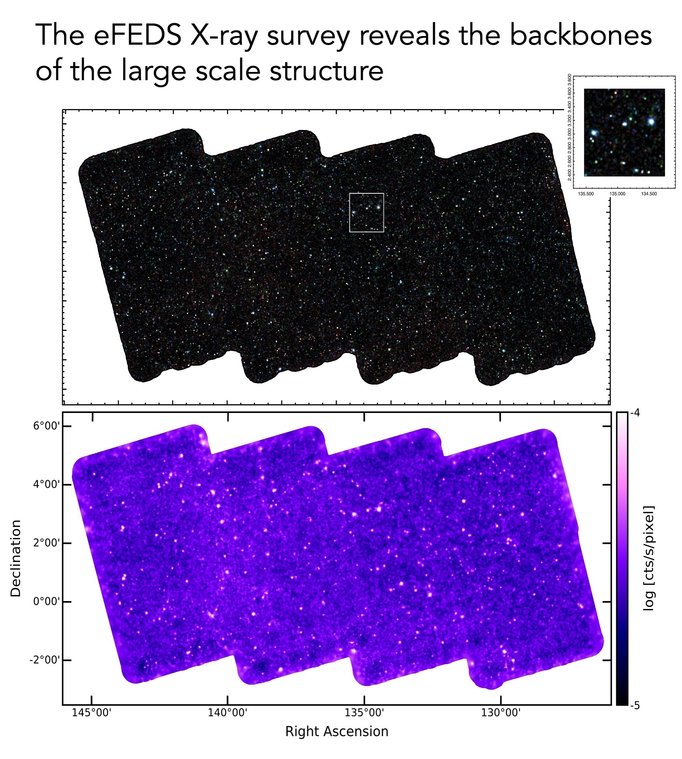 The image above gives a glimpse on this dataset. The top panel shows all sources, color-coded by the energy of the photons. The inset is a zoom onto a "supercluster", i.e. a conglomeration of clusters of galaxies about to merge. In bottom panel, all stars and AGN (i.e. all the point sources) have been filtered out from the eFEDS X-ray image. What is left is the diffuse emission from clusters and groups of galaxies, the matter in between, and the halo of the MilkyWay in front. As such, it gives a visual illustration of the large-scale structure that is almost impossible to gain otherwise.
The image above gives a glimpse on this dataset. The top panel shows all sources, color-coded by the energy of the photons. The inset is a zoom onto a "supercluster", i.e. a conglomeration of clusters of galaxies about to merge. In bottom panel, all stars and AGN (i.e. all the point sources) have been filtered out from the eFEDS X-ray image. What is left is the diffuse emission from clusters and groups of galaxies, the matter in between, and the halo of the MilkyWay in front. As such, it gives a visual illustration of the large-scale structure that is almost impossible to gain otherwise.
More details are available at MPE website and of course in the papers describing science we were able to do with the released data already and now making a splash on arxiv!
Jun 18, 2021
After a long careful analysis and writing up of the results, another joint DE/RU paper
inspired by SRG and led by IKI collegues is finally
accepted. We mostly focus on
analysis of NuSTAR data obtained following our TOO request, and report
discovery of the four cyclotron lines in the broadband X-ray spectrum of a transient Be/X-ray binary Swift J1626.6-5156.
Besides the mere number of harmonics detected, the funny part is the energy of the fundamental of 4.9 keV, the lowest among all X-ray pulsars!
This implies that the source has the weakest confirmed magnetic field among all X-ray
pulsars $B\sim4\times10^{11}$G and makes it a prime target for the upcoming X-ray polarimetry missions covering soft X-ray band such as
IXPE and eXTP. For other pulsars the region around the resonanse (typically above 20 keV) is not observable by those missions, and there lots of interesting things are expected to happen in terms of polarimetric properties!
Up to now our only hope was GRO J1744-28 which also has a line at 4.5 keV, and has also shown a smallish outburst recently,
so now we have two transients to watch for once IXPE launches this autumn. The more the merrier, obviously! Especially considering that Swift J1626.6-5156 appears to exhibit more or less regular (albeit low luminosity) outbursts.
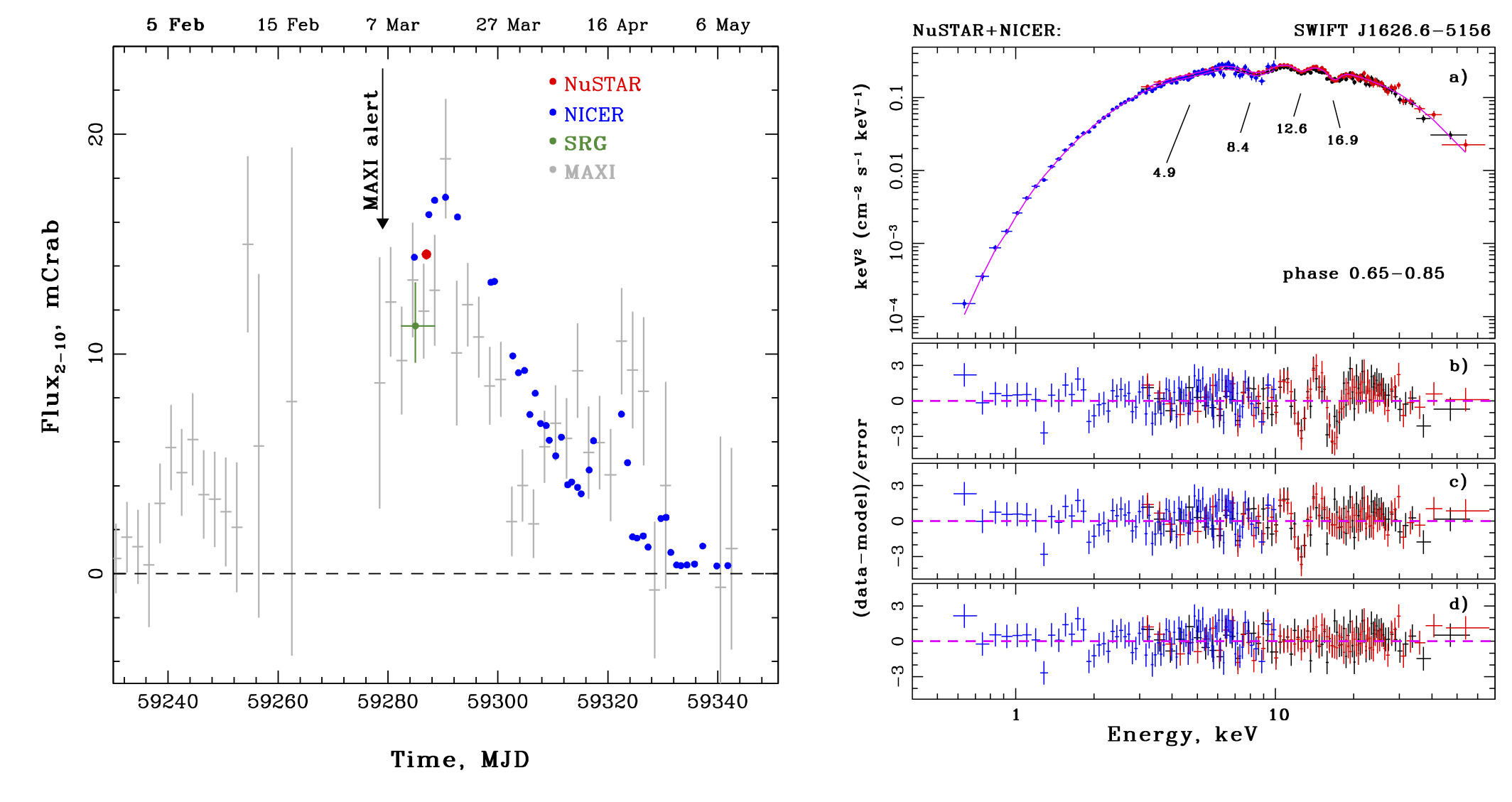
The contribution of SRG to the
discovery was minor but essential as the initial
alert by MAXI only
indicated some elevated activity, so stronger justification was needed to trigger
NuSTAR which ART-XC and
eRosita were able to provide as coincidentely SRG scanned over the source just a couple of days after the first reports of activity thereby unambigously confirming detection.
Apr 21, 2021
Theseus is going to revolutionize GRB science, but is also highly relevant for many other science cases. In support for the mission we've prepared a splash of papers discussing a wide range of science topics where Theseus can shine:
Mar 31, 2021
Another interesting work led by Chinese Insight-HXMT collegues about my favorite source related to the spin-up episode we discused earlier.
GX 301-2 provides a rare opportunity to study both disk and wind accretion in a same target.
We reported on Insight-HXMT observations of the spin-up event of GX 301-2 happened in 2019 and compare with those of wind-fed state, which allowed to detect interesting pulse profile changes.
Inspection of the Fermi/GBM data also confirmed Insight-HXMT results. We discuss possible differences between disk and wind
accretion that may explain the observed different trend of pulse profiles.
Mar 24, 2021
After the paper describing eRosita onboard SRG, now the paper describing the second instrument, ART-XC is out. If I'm not mistaken, that's the first Russian X-ray telescope with focussing optics, and the first focusing telescope doing an all-sky survey above 4\,keV at all. Sometimes overshadowed by eRosita in the eyes of international community, it's a very nice instrument in it's own and will certainly contribute to success of the SRG as a whole. If you are interested about it's science goals and performance, please read the paper linked above. From my side, warm congratulations to IKI collegues on getting the paper out!
Mar 23, 2021
Today the conference devoted to science possible with Theseus where IAAT is involved kicks in. There are many interesting talks in the program, be
sure to check, and see you there if you're attending!
Mar 11, 2021
The first proper paper by ART-XC onboard SRG is out!.
GRO J1008-57 was the first source where we understood that accretion in quiescent BeXRBs might occur from a cold, non-ionized, low-viscosity accretion disk, much like in quiet periods of dwarf novae.
The statistics of Swift/XRT and short Chandra pointing did not permit us at the time, however, to definitively prove that also the pulsar remains active, so we tried to get XMM data several times to do that, but without much success.
Fortunately, the source was observed in quiescence by ART-XC telescope during the performance verification phase of SRG (hosting ART-XC and eRosita telescopes). This allowed to detect pulsations, and study the source properties in detail using the follow-up DDT NuSTAR observation

As you can see, our results show that pulsations from GRO J1008-57 in quiescence are detected both by NuSTAR and ART-XC, and the broadband X-ray spectrum resembles that of other low luminosity X-ray pulsars like X Persei, GX 304-1, 1A 0535+262 or SGR 0755−2933.
Congratulations to ART-XC team on this result!
Jan 29, 2021
We've just found a new Galactic BeXRB! See, i.e. telegrams 14357,
14361 and 14364.
On Jan 27, 2021, during the third consecutive all-sky survey, the Mikhail
Pavlinsky ART-XC telescope on board the SRG observatory discovered a bright
X-ray source at RA, Dec = 191.0172deg, -63.3756deg (J2000) with a 90% error
radius of 25". The position was later refined by looking into archival eRosita data, which allowed to pinpoint
the optical counterpart (Be star). We've triggered NuSTAR observations and the results suggest that's indeed a new X-ray pulsar!
Jan 26, 2021
A new paper building upon
our earlier work on accretion in magnetars has just been published.
The soft gamma-ray repeater candidate SGR 0755-2933 was discovered in 2016 by
Swift/BAT, which detected a short (~30 ms) powerful burst typical of
magnetars. To understand the nature of the source, we analyzed follow-up
observations of the tentative soft X-ray counterpart of the source obtained
with Swift/XRT, NuSTAR and Chandra. As a result we found that based on the
observed counterpart position and properties, it is actually not a soft gamma
ray repeater but rather a new high mass X-ray binary. We suggest to refer to it
as 2SXPS J075542.5-293353 while the true soft X-ray counterpart
to the burst event remain a mystery. Presence of a soft counterpart is, however, essential to
unambiguously associate the burst with a magnetar flare, and thus we conclude
that magnetar origin of SRG 0755-2933 requires further investigation.
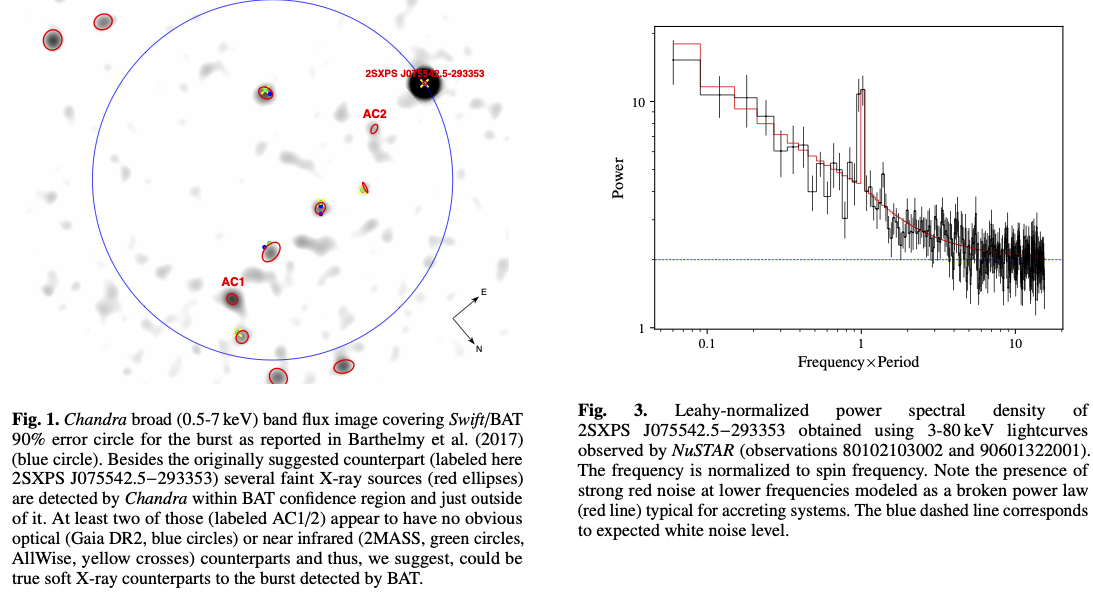
Jan 18, 2021
Some nice use of NOT and of course NuSTAR in work led by S. Tsygankov which just has been published.
We present results of a detailed investigation of the poorly studied X-ray
pulsar XTE J1858+034 based on the data obtained with the NuSTAR observatory
during the outburst of the source in 2019. The spectral analysis resulted in
the discovery of a cyclotron absorption feature in the source spectrum at ~48
keV both in the pulse phase averaged and resolved spectra. Accurate X-ray
localization of the source using the NuSTAR and Chandra observatories allowed
us to accurately determine the position of the X-ray source and identify the
optical companion of the pulsar. The analysis of the counterpart properties
suggested that the system is likely a symbiotic binary hosting an X-ray pulsar
and a late type companion star of K-M classes rather than Be X-ray binary as
previously suggested.
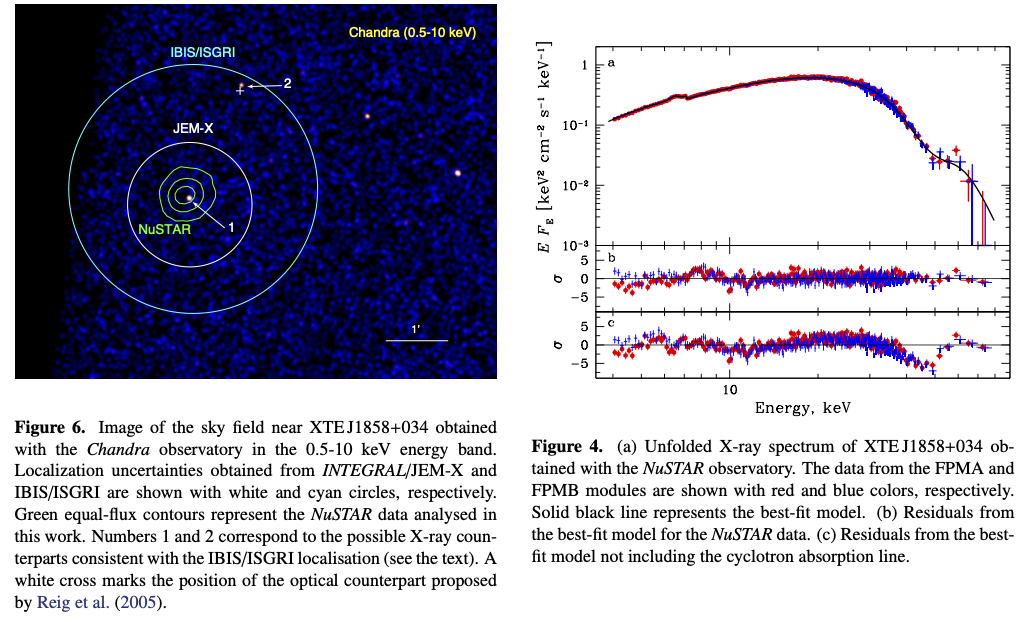
Jan 18, 2021
Picture of the week at HEASARC is something for the mission!
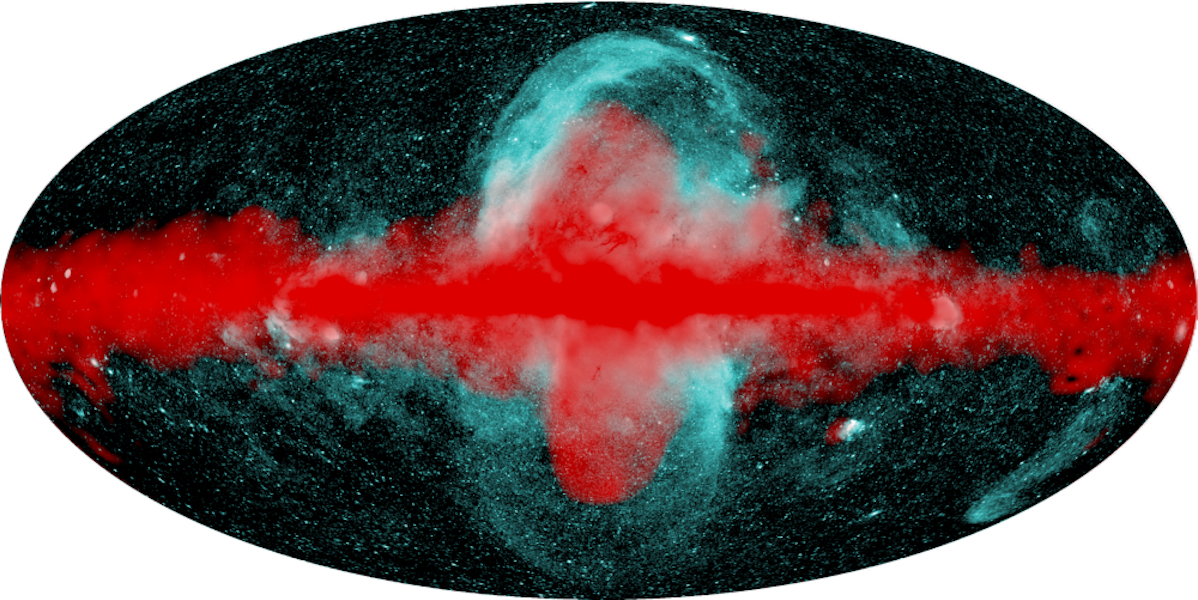
One of the most surprising structures associated with our home galaxy, the
Milky Way, are the gamma-ray emitting, bubble-like structures extending more
than 25,000 light years above and below the center of the Galaxty. These
bubbles were discovered by the Fermi Gamma-Ray Space Telescpe about a decade
ago, and now affectionately known as the "Fermi Bubbles" by astronomers.
Clearly the result of some remarkable outpouring of energy near the center of
the Milky Way, the event (or series of events) that blew the "Fermi Bubbles" is
still not entirely understood. A new all-sky X-ray map obtained by the eROSITA
telescope on the Spektr-RG spacecraft may help solve this problem. The image
above shows composite all-sky maps centered on the center of the Milky Way (so
that the disk of the Milky Way stretches from left to right at the middle of
the image, and the center of the Milky Way is at the center of the image). The
gamma-ray map from Fermi is shown in red, while the X-ray map from eROSITA is
shown in blue. The Fermi image shows the Fermi Bubbles emanating from the
center of the Milky Way above and below the disk of the Galaxy. The X-ray image
from eROSITA also shows similar X-ray bubbles above and below the Galaxy, but
about twice as large as the Fermi bubbles, each having a diameter of about
45,000 lightyears. Analysis of the X-ray "eROSITA Bubbles" suggest that these
bubbles are probably the remnants of an enormous but temporary burst of energy
from Sgr A*, the 4-million solar mass black hole at the center of the Milky
Way, about a Fermi bubble diameter away from us. The outburst might have
happened if Sgr A* swallowed a massive cloud of gas (or perhaps some
unfortunate star or group of stars) a few million years ago, and, for a million
years or two, formed a disk of accreting matter and shot a particle beam into
space perpendicular to the Galaxy's disk, blowing out material that we seen now
as the Fermi/eROSITA bubbles. Sometime after this feeding frenzy, the monster
black hole afterwards fell into its current sleepy state.
Dec 04, 2020
Another nice work based on Insight-HXMT data. The last one for Long Ji while in Tuebingen :(
Congratulations on new position, Long!
In the paper investigate the absorption and emission features in observations of GX 301-2
detected with Insight-HXMT/LE in 2017-2019. At different orbital phases, we
found prominent Fe K$\alpha$, K$\beta$ and Ni K$\alpha$ lines, as well as Compton
shoulders and Fe K-shell absorption edges. These features are due to the X-ray
reprocessing caused by the interaction between the radiation from the source
and surrounding accretion material. According to the ratio of iron lines K$\alpha$
and K$\beta$, we infer the accretion material is in a low ionisation state. We
find an orbital-dependent local absorption column density, which has a large
value and strong variability around the periastron. We explain its variability
as a result of inhomogeneities of the accretion environment and/or
instabilities of accretion processes. In addition, the variable local column
density is correlated with the equivalent width of the iron K$\alpha$ lines
throughout the orbit, which suggests that the accretion material near the
neutron star is spherically distributed.
Oct 07, 2020
Years of work, Vodka@Baikonur and hours of waiting for the news of doom which did not came. Well done MPE!
Happy to be part of the team, and wish all the best for the mission!
Now the "main" paper describing the telescope has been published

Sep 29, 2020
It turns out that one can easily distinguish accreting and non-accreting
neutron stars based on their variability! The
paper which
we've just published settles a years-long dispute on whether persistent
emission of magnetars could actually be powered by accretion, and the answer is "no".
This conclusion is based on a simple fact that all accreting objects we know are variable (have noise in their power spectra),
and all non-accreting objects (including magnterars) are not as is illustrated in figure below from the paper:
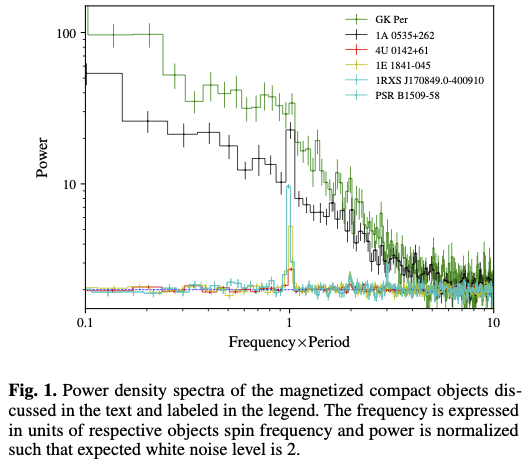
Surprisingly, the short and easy paper caused quite a bit of feedback with me getting messages from Ali Alpar,
Sandro Mereghetti, Nikos Kylafis, and others.
Some agreeing, and some disagreeing, but all friendly! Thanks for feedback and I really hope our result will be useful.
Sep 29, 2020
The first result of the collaboration between Beijing, Tuebingen and Turku on Insight-HXMT data!
We report on detailed spectral analysis of emission from X-ray pulsar 4U
1901+03 using the data obtained by the Insight-HXMT and NuSTAR observatories
during the 2019 outburst of the source. Thanks to the extensive coverage of the
outburst by Insight-HXMT, we were able to investigate spectral evolution of the
source as a function of flux, and compare these results to the previous reports
with focus on the properties of a putative absorption feature at around 10 keV.
In particular, we demonstrate that the broadband X-ray continuum of 4U 1901+03
can be well described with a two-component continuum model without absorption
line at 10 keV, which casts doubt on its interpretation as a cyclotron line.
The high quality of the data has also allowed us to perform both phase-averaged
and phase-resolved spectral analysis as function of luminosity. Finally, we
performed a detailed investigation of another absorption feature in the
spectrum of the source around 30 keV recently reported in the NuSTAR data. In
line with the previous findings, we show that this feature appears to be
significantly detected, albeit only in the pulse-phase resolved spectra at
relatively high luminosities. The non-detection of the line in the averaged
spectrum is possibly associated with the observed strong variations of its
parameters with the pulse phase.
Sep 29, 2020
Another paper based on Insight-HXMT and led by Long Ji.
We report on our analysis of the 2019 outburst of the X-ray accreting pulsar 4U
1901+03 observed with Insight-HXMT and NICER. Both spectra and pulse profiles
evolve significantly in the decaying phase of the outburst. Dozens of flares
are observed throughout the outburst. They are more frequent and brighter at
the outburst peak. We find that the flares, which have a duration from tens to
hundreds of seconds, are generally brighter than the persistent emission by a
factor of ∼1.5. The pulse-profile shape during the flares can be significantly
different from that of the persistent emission. In particular, a phase shift is
clearly observed in many cases. We interpret these findings as direct evidence
of changes of the pulsed beam pattern, due to transitions between the sub- and
supercritical accretion regimes on a short time-scale. We also observe that at
comparable luminosities the flares' pulse profiles are rather similar to those
of the persistent emission. This indicates that the accretion on the polar cap
of the neutron star is mainly determined by the luminosity, I.e. the mass
accretion rate.
Sep 29, 2020
This one had made our heads scratch for a while...
We present the results of the first dedicated observation of the young X-ray
pulsar SXP 1062 in the broad X-ray energy band obtained during its 2019
outburst with the NuSTAR and XMM-Newton observatories. The analysis of the
pulse-phase averaged and phase-resolved spectra in the energy band from 0.5 to
70 keV did not reveal any evidence for the presence of a cyclotron line. The
spin period of the pulsar was found to have decreased to 979.48±0.06 s
implying a ∼10% reduction compared to the last measured period during the
monitoring campaign conducted about five years ago, and is puzzling considering
that the system apparently has not shown major outbursts ever since. The switch
of the pulsar to the spin-up regime supports the common assumption that torques
acting on the accreting neutron star are nearly balanced and thus SXP 1062
likely also spins with a period close to the equilibrium value for this system.
The current monitoring of the source also revealed a sharp drop in its soft
X-ray flux right after the outburst, which is in drastic contrast to the
behavior during the previous outburst when the pulsar remained observable for
years with only a minor flux decrease after the end of the outburst. This
unexpected off state of the source lasted for at most 20 days after which SXP
1062 returned to the level observed during previous campaigns. We discuss this
and other findings in context of the modern models of accretion onto strongly
magnetized neutron stars.
 Based on these results, we speculate that when the source enters the supercritical regime, the higher accretion column can significantly enhance the harmonic line at a narrow phase through an "anti-pencil" beam at a higher energy band. At the same time, it will also affect the behavior of the fundamental line.
Based on these results, we speculate that when the source enters the supercritical regime, the higher accretion column can significantly enhance the harmonic line at a narrow phase through an "anti-pencil" beam at a higher energy band. At the same time, it will also affect the behavior of the fundamental line.

 The image above gives a glimpse on this dataset. The top panel shows all sources, color-coded by the energy of the photons. The inset is a zoom onto a "supercluster", i.e. a conglomeration of clusters of galaxies about to merge. In bottom panel, all stars and AGN (i.e. all the point sources) have been filtered out from the eFEDS X-ray image. What is left is the diffuse emission from clusters and groups of galaxies, the matter in between, and the halo of the MilkyWay in front. As such, it gives a visual illustration of the large-scale structure that is almost impossible to gain otherwise.
The image above gives a glimpse on this dataset. The top panel shows all sources, color-coded by the energy of the photons. The inset is a zoom onto a "supercluster", i.e. a conglomeration of clusters of galaxies about to merge. In bottom panel, all stars and AGN (i.e. all the point sources) have been filtered out from the eFEDS X-ray image. What is left is the diffuse emission from clusters and groups of galaxies, the matter in between, and the halo of the MilkyWay in front. As such, it gives a visual illustration of the large-scale structure that is almost impossible to gain otherwise.




